ESP AUDI A5 COUPE 2008 Repair Manual
[x] Cancel search | Manufacturer: AUDI, Model Year: 2008, Model line: A5 COUPE, Model: AUDI A5 COUPE 2008Pages: 313, PDF Size: 13.86 MB
Page 252 of 313
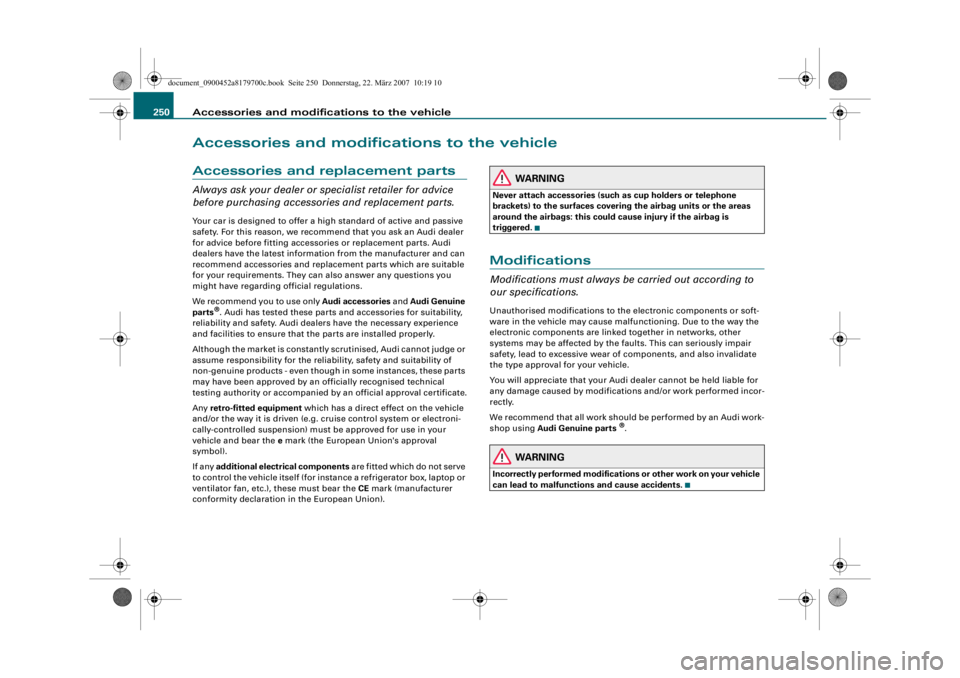
Accessories and modifications to the vehicle
250Accessories and modificat ions to the vehicleAccessories and replacement partsAlways ask your dealer or specialist retailer for advice
before purchasing accessories and replacement parts.Your car is designed to offer a high standard of active and passive
safety. For this reason, we recommend that you ask an Audi dealer
for advice before fitting accessories or replacement parts. Audi
dealers have the latest information from the manufacturer and can
recommend accessories and replacement parts which are suitable
for your requirements. They can also answer any questions you
might have regarding official regulations.
We recommend you to use only Audi accessories and Audi Genuine
parts
®. Audi has tested these parts and accessories for suitability,
reliability and safety. Audi dealers have the necessary experience
and facilities to ensure that the parts are installed properly.
Although the market is constantly scrutinised, Audi cannot judge or
assume responsibility for the reliability, safety and suitability of
non-genuine products - even though in some instances, these parts
may have been approved by an officially recognised technical
testing authority or accompanied by an official approval certificate.
Any retro-fitted equipment which has a direct effect on the vehicle
and/or the way it is driven (e.g. cruise control system or electroni-
cally-controlled suspension) must be approved for use in your
vehicle and bear the e mark (the European Union's approval
symbol).
If any additional electrical components are fitted which do not serve
to control the vehicle itself (for inst ance a refrigerator box, laptop or
ventilator fan, etc.), these must bear the CE mark (manufacturer
conformity declaration in the European Union).
WARNING
Never attach accessories (such as cup holders or telephone
brackets) to the surfaces coverin g the airbag units or the areas
around the airbags: this could cause injury if the airbag is
triggered.ModificationsModifications must always be carried out according to
our specifications.Unauthorised modifications to the electronic components or soft-
ware in the vehicle may cause malfunctioning. Due to the way the
electronic components are linked together in networks, other
systems may be affected by the faults. This can seriously impair
safety, lead to excessive wear of components, and also invalidate
the type approval for your vehicle.
You will appreciate that your Audi dealer cannot be held liable for
any damage caused by modifications and/or work performed incor-
rectly.
We recommend that all work should be performed by an Audi work-
shop using Audi Genuine parts
®.
WARNING
Incorrectly performed modifications or other work on your vehicle
can lead to malfunctions and cause accidents.
document_0900452a8179700c.book Seite 250 Donnerstag, 22. März 2007 10:19 10
--4 -
-T
-+ +-
. I
Page 269 of 313
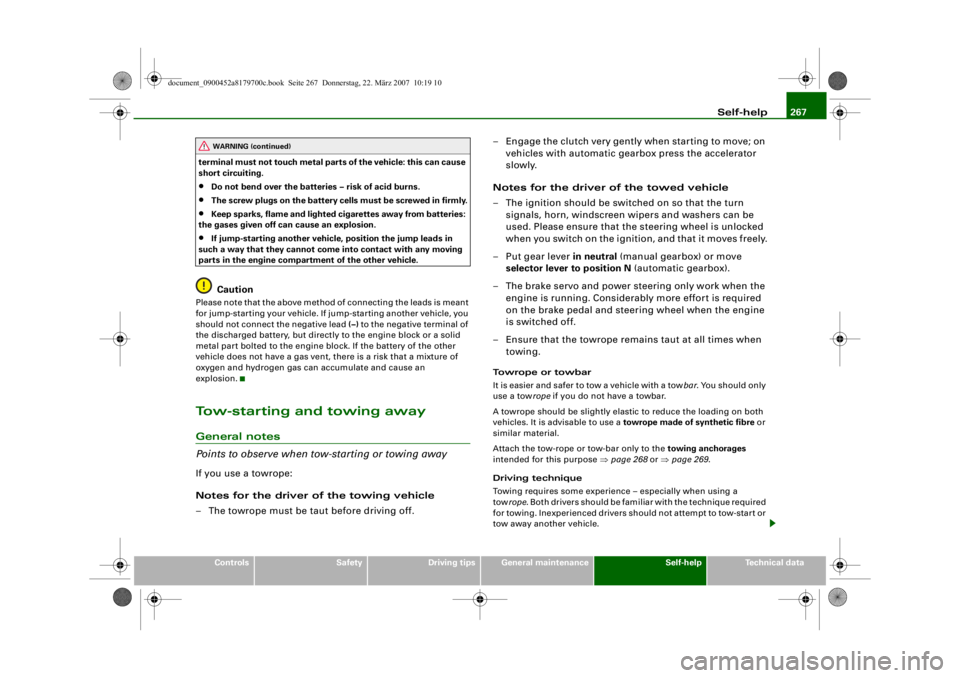
Self-help267
Controls
Safety
Driving tips
General maintenance
Self-help
Technical data
terminal must not touch metal parts of the vehicle: this can cause
short circuiting.
•
Do not bend over the batteries – risk of acid burns.
•
The screw plugs on the battery ce
lls must be screwed in firmly.
•
Keep sparks, flame and lighted cigarettes away from batteries:
the gases given off can cause an explosion.
•
If jump-starting another vehicle, position the jump leads in
such a way that they cannot come into contact with any moving
parts in the engine compart ment of the other vehicle.Caution
Please note that the above method of connecting the leads is meant
for jump-starting your vehicle. If jump-starting another vehicle, you
should not connect the negative lead (–) to the negative terminal of
the discharged battery, but directly to the engine block or a solid
metal part bolted to the engine bl ock. If the battery of the other
vehicle does not have a gas vent, there is a risk that a mixture of
oxygen and hydrogen gas can accumulate and cause an
explosion.Tow-starting and towing awayGeneral notes
Points to observe when tow-starting or towing awayIf you use a towrope:
Notes for the driver of the towing vehicle
– The towrope must be taut before driving off. – Engage the clutch very gently when starting to move; on
vehicles with automatic gearbox press the accelerator
slowly.
Notes for the driver of the towed vehicle
– The ignition should be switched on so that the turn signals, horn, windscreen wipers and washers can be
used. Please ensure that the steering wheel is unlocked
when you switch on the ignition, and that it moves freely.
–Put gear lever in neutral (manual gearbox) or move
selector lever to position N (automatic gearbox).
– The brake servo and power steering only work when the engine is running. Considerably more effort is required
on the brake pedal and steering wheel when the engine
is switched off.
– Ensure that the towrope remains taut at all times when towing.
Towrope or towbar
It is easier and safer to tow a vehicle with a tow bar. You should only
use a tow rope if you do not have a towbar.
A towrope should be slightly elasti c to reduce the loading on both
vehicles. It is advisable to use a towrope made of synthetic fibre or
similar material.
Attach the tow-rope or tow-bar only to the towing anchorages
intended for this purpose ⇒page 268 or ⇒page 269 .
Driving technique
Towing requires some experience – especially when using a
tow rope . Both drivers should be familiar with the technique required
for towing. Inexperienced drivers sh ould not attempt to tow-start or
tow away another vehicle.
WARNING (continued)
document_0900452a8179700c.book Seite 267 Donnerstag, 22. März 2007 10:19 10
--4 -
-T
CD
-+ +-
•
Page 276 of 313
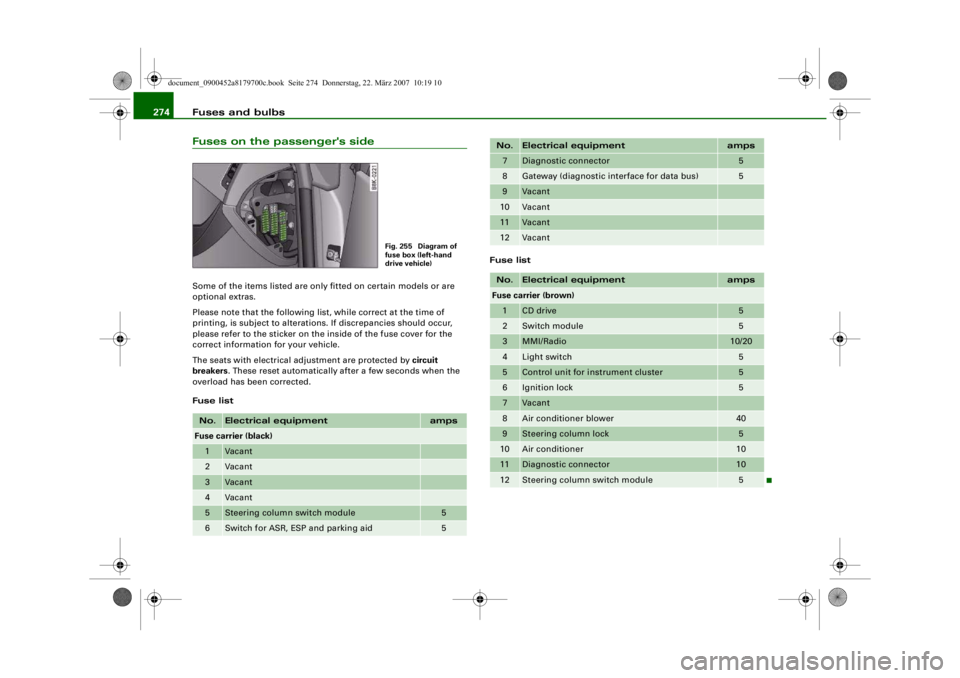
Fuses and bulbs
274Fuses on the passenger's sideSome of the items listed are only fitted on certain models or are
optional extras.
Please note that the following li st, while correct at the time of
printing, is subject to alterations. If discrepancies should occur,
please refer to the sticker on the inside of the fuse cover for the
correct information for your vehicle.
The seats with electrical adjustment are protected by circuit
breakers . These reset automatically after a few seconds when the
overload has been corrected.
Fuse list Fuse listNo.
Electrical equipment
amps
Fuse carrier (black)1
Vacant
2
Vacant
3
Vacant
4
Vacant
5
Steering column switch module
5
6
Switch for ASR, ESP and parking aid
5
Fig. 255 Diagram of
fuse box (left-hand
drive vehicle)
7
Diagnostic connector
5
8
Gateway (diagnostic in
terface for data bus)
5
9
Vacant
10
Vacant
11
Vacant
12
Vacant
No.
Electrical equipment
amps
Fuse carrier (brown)1
CD drive
5
2
Switch module
5
3
MMI/Radio
10/20
4
Light switch
5
5
Control unit for instrument cluster
5
6
Ignition lock
5
7
Vacant
8
Air conditioner blower
40
9
Steering column lock
5
10
Air conditioner
10
11
Diagnostic connector
10
12
Steering column switch module
5
No.
Electrical equipment
amps
document_0900452a8179700c.book Seite 274 Donnerstag, 22. März 2007 10:19 10
-+ ~
--11-
..
-
..
-
..
-
..
-
..
..
..
..
..
..
..
..
..
..
..
--4 -
-
-
T
-
-
-
-
-
+-
-
-
-
-
-
•
4-
---r
Page 279 of 313
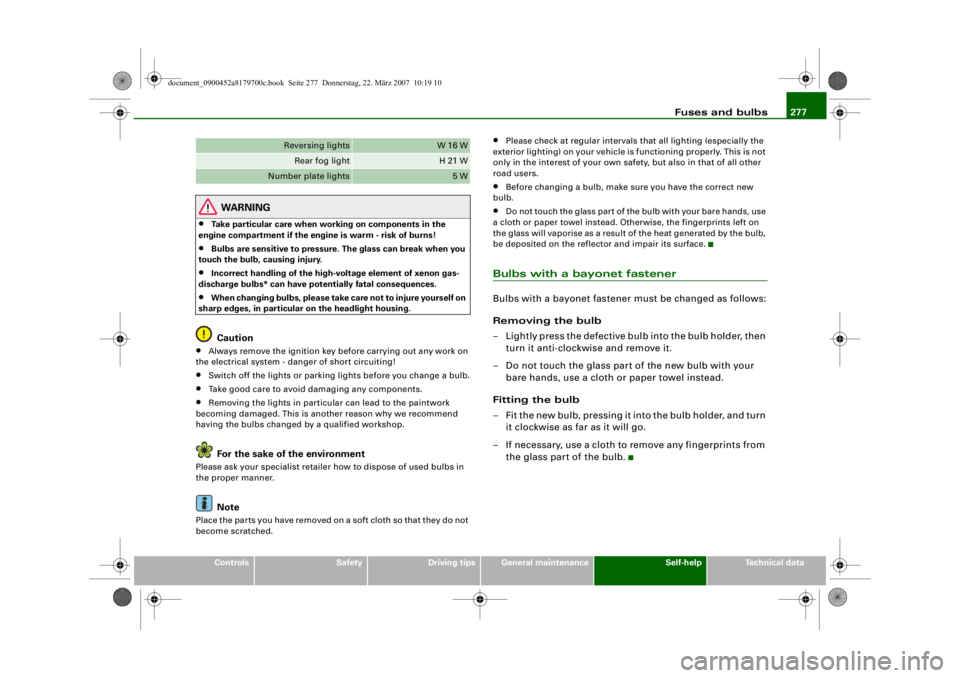
Fuses and bulbs277
Controls
Safety
Driving tips
General maintenance
Self-help
Technical data
WARNING
•
Take particular care when working on components in the
engine compartment if the engine is warm - risk of burns!
•
Bulbs are sensitive to pressure. The glass can break when you
touch the bulb, causing injury.
•
Incorrect handling of the high-voltage element of xenon gas-
discharge bulbs* can have potentially fatal consequences.
•
When changing bulbs, please take care not to injure yourself on
sharp edges, in particular on the headlight housing.Caution
•
Always remove the ignition key before carrying out any work on
the electrical system - danger of short circuiting!
•
Switch off the lights or parking lights before you change a bulb.
•
Take good care to avoid damaging any components.
•
Removing the lights in particular can lead to the paintwork
becoming damaged. This is another reason why we recommend
having the bulbs changed by a qualified workshop.For the sake of the environment
Please ask your specialist retailer how to dispose of used bulbs in
the proper manner.
Note
Place the parts you have removed on a soft cloth so that they do not
become scratched.
•
Please check at regular intervals that all lighting (especially the
exterior lighting) on your vehicle is functioning properly. This is not
only in the interest of your own sa fety, but also in that of all other
road users.
•
Before changing a bulb, make sure you have the correct new
bulb.
•
Do not touch the glass part of the bulb with your bare hands, use
a cloth or paper towel instead. Otherwise, the fingerprints left on
the glass will vaporise as a result of the heat generated by the bulb,
be deposited on the reflector and impair its surface.
Bulbs with a bayonet fastenerBulbs with a bayonet fastener must be changed as follows:
Removing the bulb
– Lightly press the defective bulb into the bulb holder, then turn it anti-clockwise and remove it.
– Do not touch the glass part of the new bulb with your bare hands, use a cloth or paper towel instead.
Fitting the bulb
– Fit the new bulb, pressing it into the bulb holder, and turn it clockwise as far as it will go.
– If necessary, use a cloth to remove any fingerprints from the glass part of the bulb.
Reversing lights
W 16 W
Rear fog light
H 21 W
Number plate lights
5 W
document_0900452a8179700c.book Seite 277 Donnerstag, 22. März 2007 10:19 10
--4 -
-T
•
-+
0
+-
•
[I]
Page 295 of 313
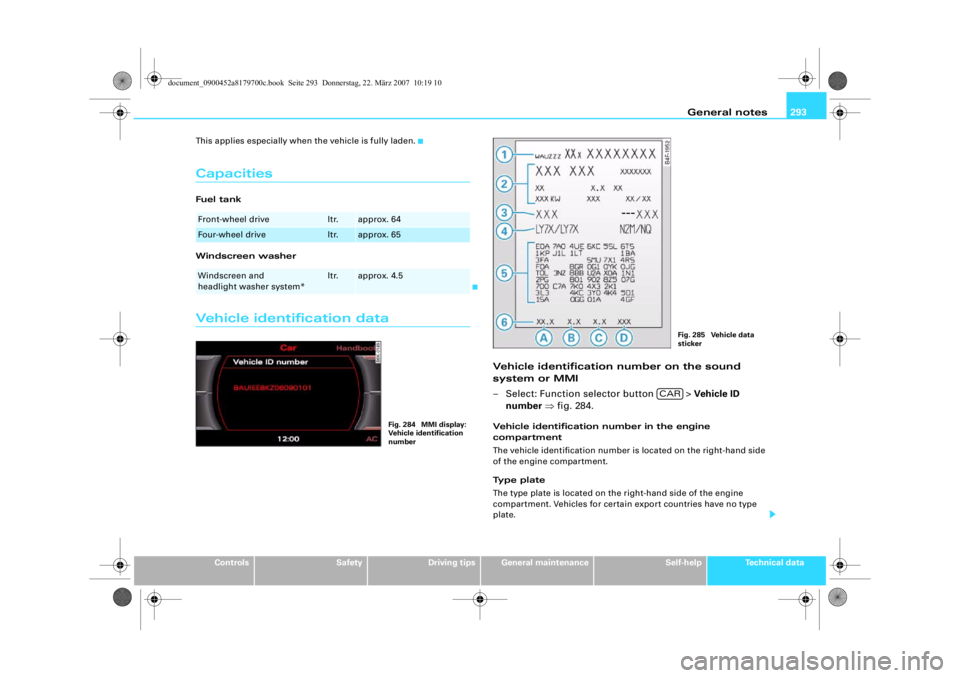
General notes293
Controls
Safety
Driving tips
General maintenance
Self-help
Technical data
This applies especially when the vehicle is fully laden.
CapacitiesFuel tank
Windscreen washerVehicle identification data
Vehicle identification
number on the sound
system or MMI
– Select: Function selector button > Vehicle ID
number ⇒ fig. 284.Vehicle identification number in the engine
compartment
The vehicle identification number is located on the right-hand side
of the engine compartment.
Type plate
The type plate is located on the right-hand side of the engine
compartment. Vehicles for certain export countries have no type
plate.
Front-wheel drive
ltr.
approx. 64
Four-wheel drive
ltr.
approx. 65
Windscreen and
headlight washer system*
ltr.
approx. 4.5
Fig. 284 MMI display:
Vehicle identification
number
Fig. 285 Vehicle data
sticker
CAR
document_0900452a8179700c.book Seite 293 Donnerstag, 22. März 2007 10:19 10
T
•
-+
I
~;;~ x1~~xxx,;;;,:x ~ :X.Kw
,;;;,_x xx
XX/XX
XXX ---XXX
L Y7X/LY7X N2M/NQ ,.... EOA
7f'D
4UE 6XC 5SL 6TS
11
FOA 6i:;ll OGl OYI< OJG
- TOL JNZ 8BB LIZA
XOA
!Nl
2PG 801
902
825 07G
• 700 C7A 71<0 4XJ 2Kl
)LJ
'lKC
3YO 4K4 501
_ lSA OGG 01A 4 GF
+-
Page 307 of 313
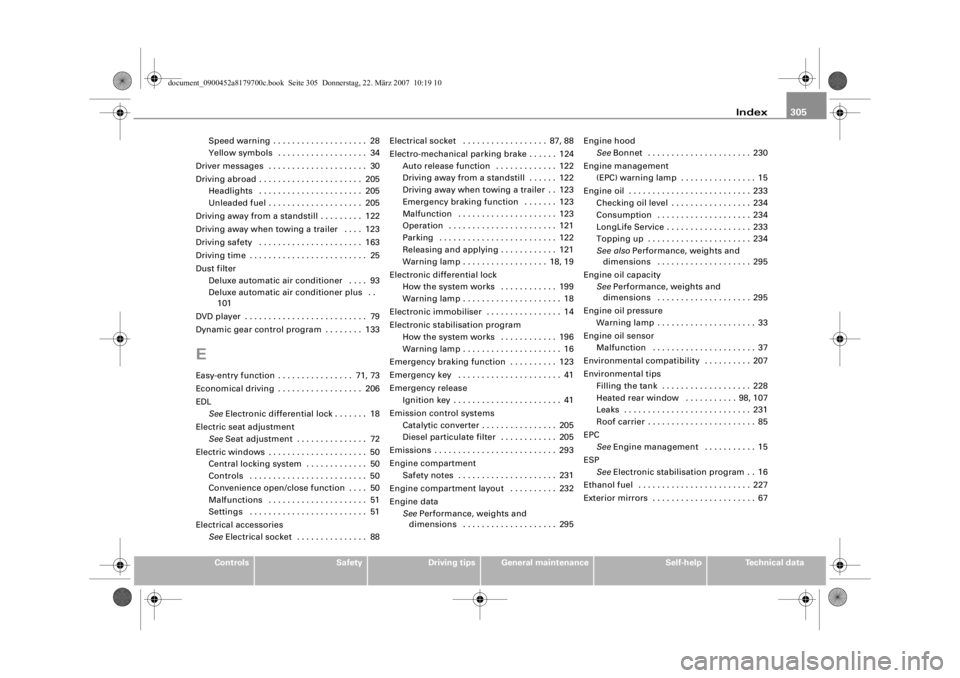
Index305
Controls
Safety
Driving tips
General maintenance
Self-help
Technical data
Speed warning . . . . . . . . . . . . . . . . . . . . 28
Yellow symbols . . . . . . . . . . . . . . . . . . . 34
Driver messages . . . . . . . . . . . . . . . . . . . . . 30
Driving abroad . . . . . . . . . . . . . . . . . . . . . . 205 Headlights . . . . . . . . . . . . . . . . . . . . . . 205
Unleaded fuel . . . . . . . . . . . . . . . . . . . . 205
Driving away from a standstill . . . . . . . . . 122
Driving away when towing a trailer . . . . 123
Driving safety . . . . . . . . . . . . . . . . . . . . . . 163
Driving time . . . . . . . . . . . . . . . . . . . . . . . . . 25
Dust filter Deluxe automatic air conditioner . . . . 93
Deluxe automatic air conditioner plus . . 101
DVD player . . . . . . . . . . . . . . . . . . . . . . . . . . 79
Dynamic gear control program . . . . . . . . 133
EEasy-entry function . . . . . . . . . . . . . . . . 71, 73
Economical driving . . . . . . . . . . . . . . . . . . 206
EDL See Electronic differential lock . . . . . . . 18
Electric seat adjustment See Seat adjustment . . . . . . . . . . . . . . . 72
Electric windows . . . . . . . . . . . . . . . . . . . . . 50 Central locking system . . . . . . . . . . . . . 50
Controls . . . . . . . . . . . . . . . . . . . . . . . . . 50
Convenience open/close function . . . . 50
Malfunctions . . . . . . . . . . . . . . . . . . . . . 51
Settings . . . . . . . . . . . . . . . . . . . . . . . . . 51
Electrical accessories See Electrical socket . . . . . . . . . . . . . . . 88 Electrical socket . . . . . . . . . . . . . . . . . . 87, 88
Electro-mechanical parking brake . . . . . . 124
Auto release function . . . . . . . . . . . . . 122
Driving away from a standstill . . . . . . 122
Driving away when towing a trailer . . 123
Emergency braking function . . . . . . . 123
Malfunction . . . . . . . . . . . . . . . . . . . . . 123
Operation . . . . . . . . . . . . . . . . . . . . . . . 121
Parking . . . . . . . . . . . . . . . . . . . . . . . . . 122
Releasing and applying . . . . . . . . . . . . 121
Warning lamp . . . . . . . . . . . . . . . . . . 18, 19
Electronic differential lock How the system works . . . . . . . . . . . . 199
Warning lamp . . . . . . . . . . . . . . . . . . . . . 18
Electronic immobiliser . . . . . . . . . . . . . . . . 14
Electronic stab ilisation program
How the system works . . . . . . . . . . . . 196
Warning lamp . . . . . . . . . . . . . . . . . . . . . 16
Emergency braking function . . . . . . . . . . 123
Emergency key . . . . . . . . . . . . . . . . . . . . . . 41
Emergency release Ignition key . . . . . . . . . . . . . . . . . . . . . . . 41
Emission control systems Catalytic converter . . . . . . . . . . . . . . . . 205
Diesel particulate filter . . . . . . . . . . . . 205
Emissions . . . . . . . . . . . . . . . . . . . . . . . . . . 293
Engine compartment Safety notes . . . . . . . . . . . . . . . . . . . . . 231
Engine compartment layout . . . . . . . . . . 232
Engine data See Performance, weights and
dimensions . . . . . . . . . . . . . . . . . . . . 295 Engine hood
See Bonnet . . . . . . . . . . . . . . . . . . . . . . 230
Engine management (EPC) warning lamp . . . . . . . . . . . . . . . . 15
Engine oil . . . . . . . . . . . . . . . . . . . . . . . . . . 233 Checking oil level . . . . . . . . . . . . . . . . . 234
Consumption . . . . . . . . . . . . . . . . . . . . 234
LongLife Service . . . . . . . . . . . . . . . . . . 233
Topping up . . . . . . . . . . . . . . . . . . . . . . 234
See also Performance, weights and
dimensions . . . . . . . . . . . . . . . . . . . . 295
Engine oil capacity See Performance, weights and
dimensions . . . . . . . . . . . . . . . . . . . . 295
Engine oil pressure Warning lamp . . . . . . . . . . . . . . . . . . . . . 33
Engine oil sensor Malfunction . . . . . . . . . . . . . . . . . . . . . . 37
Environmental compatibility . . . . . . . . . . 207
Environmental tips Filling the tank . . . . . . . . . . . . . . . . . . . 228
Heated rear window . . . . . . . . . . . 98, 107
Leaks . . . . . . . . . . . . . . . . . . . . . . . . . . . 231
Roof carrier . . . . . . . . . . . . . . . . . . . . . . . 85
EPC See Engine management . . . . . . . . . . . 15
ESP See Electronic stabilis ation program . . 16
Ethanol fuel . . . . . . . . . . . . . . . . . . . . . . . . 227
Exterior mirrors . . . . . . . . . . . . . . . . . . . . . . 67
document_0900452a8179700c.book Seite 305 Donnerstag, 22. März 2007 10:19 10
--4 -
-T
-+ +-